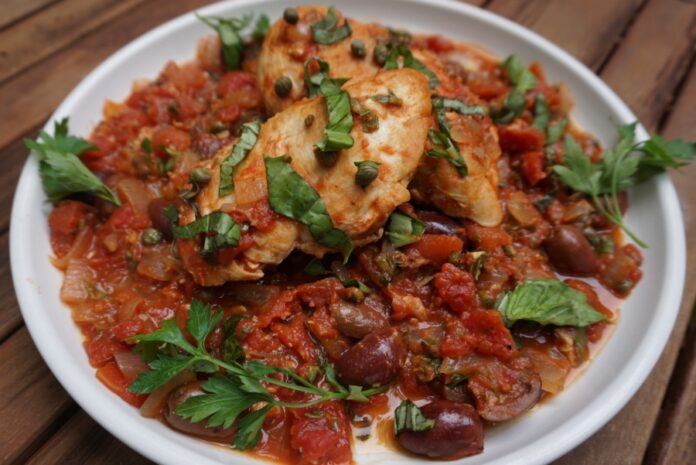Chicken Provençal
Returning home after a long Monday, I promptly marched to the kitchen, grabbed a wine glass and poured myself the last of the bottle of Chardonnay I had left over from the FarMar last Wednesday. I settled into the couch and took a sip to find a stale and unpleasant taste in my mouth — the wine had oxidized, a true tragedy. “What a waste,” I thought. It wasn’t a particularly expensive bottle of wine, but it wasn’t a two-buck Chuck either. I couldn’t bring myself to drink the rest, but it also hurt to pour it down the sink — my Monday dilemma.
Most wine is only “good” for three to five days after opening because once you remove that cork, the wine is introduced to oxygen, thus beginning the process of oxidation. Oxidation is inevitable; “We live in an environment of air, so any time the juice or wine is exposed to air, [oxidation] can happen,” said Andrew L. Waterhouse, a professor in the Viticulture and Enology department in SevenFifty Daily. When oxygen is introduced it causes the alcohol to convert to acetic acid, think vinegar, resulting in changes to color and flavor. Though usually implied negatively, introducing oxygen during the fermentation process can be a purposeful technique used by winemakers to produce a desirable “oxidative” or nutty flavor — however, I am referring to the unwelcome oxidation that happens after you open a bottle.
Back to my quandary, the perfect way to not waste your oxidized, week-old wine is to cook with it!
Chicken Provençal — saucy, boozy and utterly delicious. Impress your next date, or meal prep for a week of dinners that will turn your roommates into green eyed monsters.
Originating in Provence, France, Provençal is style of cooking in a sauce of tomatoes, garlic and olive oil — also commonly found in Provençal dishes, olives and capers.
This recipe is all about the sauce, and the chicken graciously plays the supporting role. This recipe makes enough sauce to beautifully cover four average-sized breasts, I ended up making just two chicken breasts because the sauce is so damn delicious and I like to spoon heaps of it over a serving of rice, pasta or, my favorite, quinoa. Heck, you could double up on the sauce ingredients and keep it in a tupperware container to add to a variety of dishes throughout the week.
Ingredients:
2-4 boneless, skinless chicken breasts
½ white onion, diced
2-3 large garlic cloves, minced
2-3 tablespoons olive oil
⅓ cup of white wine
1 can of diced tomatoes (14.5 oz)
½ cup pitted kalamata olives
¼ cup drained capers, roughly chopped
¼ cup basil, torn or roughly chopped
Salt and pepper to taste
Warm a large pan or deep skillet on medium heat before adding the oil. Always heat the pan before adding your oil, something I learned from Samin Nosrat’s, “Salt Fat Acid Heat.” Add half the oil and increase to high heat. Salt and pepper both sides of the chicken breasts and add to pan. Reduce heat to medium-high and cook for three to five minutes on each side, depending on the size of the breasts. Here, we are looking to brown both sides, not cook all the way through because they will finish cooking in the sauce later. Remove chicken from pan and place on a dish, cover to keep warm — I just used an upside down bowl.
Add the rest of the oil to the pan and reduce to medium-low heat. Add the onion and garlic, season with salt and pepper. Leave to sweat, stirring occasionally. Sweating means to cook the onion until it releases liquid and turns translucent. Do this for about two minutes. Then add the can of tomatoes and wine, increase to medium heat and bring to a simmer. Stir occasionally for about two minutes.
While the sauce simmers, measure ½ cup of olives and slice half of them lengthwise, leaving the rest whole. Return chicken to the pan and add olives. Bring to a boil, cover and reduce to a simmer. Let cook for 10 minutes.
Drain and measure out ¼ cup of capers, roughly chop. For the basil, you can either tear the leaves, or what I like to do, roll up 3-4 leaves at a time lengthwise and chop so you end up with little thin spirals.
Uncover and check to ensure chicken is done, if pink, continue to cook. When cooked through, remove from pan and let rest on the same plate. Stir in capers and basil and bring sauce to a boil one last time — I swear it’s worth it. Reduce to a simmer to let the sauce thicken, about four minutes. Remove from heat and let sit for a few minutes.
Pour sauce over chicken and serve with a carb of your choice and a side salad. Or go full French and boil some potatoes and sauté some green beans.
Bon appétit!
Written By: Grace Simmons — arts@theaggie.org




